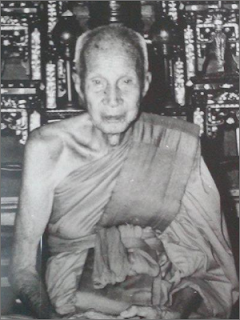Chao Khun Sri Phra Wisut Samajarn (Sri Brahmachoti Thera)
Wat Ang Sila, Chonburi • Family name: Yutha (birth name: Soonthorn)
Dawn comes early in Ban Ang Sila. On Friday, April 28, 1871 — the 11th waxing moon of the sixth lunar month — a child named Soonthorn Yutha was born into a fisherman’s town where stone mortars and sea breezes were part of every prayer. Years later people would call him simply “Chao Khun Sri.” The name stuck because the conduct fit: quiet, exacting, dependable.
At twenty, on May 14, 1891, he entered the robe at Wat Ang Sila Nai under Phra Achan Yim Tissathewa and received the monastic name Brahmachoti Thera. The old temple would later be merged into Wat Ang Sila in 1916, but his training — scripture, Vinaya, and the measured rhythms of coastal monastic life — became the bedrock of his character.
Leadership arrived like a duty accepted, not a prize won. In 1906 he became abbot of Wat Ang Sila; in 1911 preceptor of Mueang District; by 1916, Deputy Primate of Chonburi and Primate of Bang Phra; in 1933 Primate of Bang Lamung; and from 1939–1952, Provincial Primate of Chonburi. His reputation traveled faster than he did. People quoted a rough saying with a rueful smile: “If you want to trade, go to the forest temple. If you want to be a gangster, come to Wat Ang Sila.” It was less a boast than a warning — come correct, because the discipline here is unbending.
In 1952, the Sangha confirmed what the province already knew, conferring on him the high title “Chao Khun Sri” (Phra Wisut Samajarn). By then he had also deepened an esoteric strand of learning. He trained under Phra Taksin Kanisorn of Wat Tai, Bangkok, receiving the method for making Phra Phet Leek. He kept meticulous records and worked with senior rectors — Achan Yim, Rector Saeng, Rector Chan of Wat Samet — so that a ritual was never just performed, it was preserved.
His sacred works carried the same clarity. Collectors still look for his Phra Phet Leek (1952); the commanding Phra Pidta Suraphon (1957); Phra Pidta (1961) with the first-generation half-portrait coins in gold, silver, and copper; commemorative coins from 1935 and 1960; the distinct Phra Yord introduced in 1964 and reissued in 1966; and the many Phra Pidta Nakhum (large, medium, small) issued from 1964 onward. Each piece reads like a page of temple history — a blend of wicha (sacred technique), clear intention, and the needs of a growing community.
He passed on August 4, 1967, aged 97, after 76 rains in the robe. The halls he rebuilt still hold evening chants; the amulets he consecrated still sit warm in palms; the discipline he lived by still shapes the Sangha of Chonburi. His story is the story of Wat Ang Sila itself — stern where it must be, generous where it counts, and faithful in the details that keep a lineage alive.

